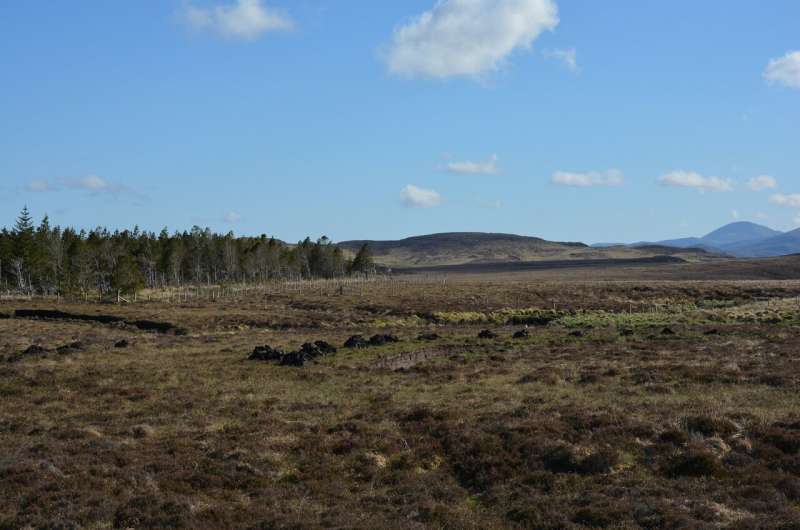This article has been reviewed according to Science X's editorial process and policies. Editors have highlighted the following attributes while ensuring the content's credibility:
fact-checked
proofread
Peatlands were drained for agriculture. Now researchers are trying to restore them

With wellies and waterproof clothing, Claudia Nielsen spent time splodging through the Bois-des-Bel peatlands earlier this year. The peatlands, located in Quebec, Canada, had been restored, with conservations working on them for 23 years. Nielsen was there to learn more about the restoration in her capacity as part of the coordination team of the EU project Wet Horizons—which aims to restore wetlands in Europe.
Statistics published by the UN in 2022 suggest that roughly 12% of the world's peatlands have been drained, though in some countries, the numbers are much higher. Germany, for example, has drained more than 90% of its peatlands. Despite covering only 3-4% of the land surface of the Earth, peatlands contain around one-third of the world's soil carbon—double the amount of carbon found in the world's forests.
"We know that draining peatlands releases this carbon as greenhouse gases, and successful restoration can halt this trend and, in some cases, turn them back into carbon sinks," said Nielsen.
Records of draining peatlands go back millennia, with evidence suggesting it happened before Roman times. Most peatland was drained in recent centuries to support agricultural expansion, both crops and livestock, among other reasons such as forestry. Globally, the largest user of drained peatland is the animal agriculture industry.
With global emissions on the rise, scientists are increasingly looking for ways to extract carbon from the atmosphere and meet the targets set out in the 2015 Paris Agreement. Researchers like Nielsen are pushing to restore peatlands to their former glory in the hopes that they can help tackle the climate crisis. She says, however, that there are still questions that need to be answered.
"Right now, a lot of peatland restoration is restricted to blocking drains to keep the peat wet," said Nielsen. Peat is a material formed by the preservation of dead organic matter, like plants. Nielsen explains that rewetting the peat stops it from drying out and decaying—a process that releases carbon dioxide. "Done in the wrong way in the wrong place, rewetted peatlands can become hotspots for emissions of another potent greenhouse gas—methane."
There are two different ways to deal with restoring peatlands, according to Nielsen: focusing on rewetting or on conservation. The former is minimal management and would involve simply blocking drains and allowing the peatlands to flood again, which would restore natural processes—akin to rewilding. The latter, on the other hand, involves more active participation. This could involve nursing crops to help create the conditions for the original vegetation found on the land to thrive.
"I am particularly impressed with the moss layer transfer technique, which is proving very successful for restoring bog peatlands by re-establishing the growth of sphagnum mosses, which are their main vegetation," said Nielsen.
Her visit to the Bois-des-Bel peatlands was inspired by this technique, as it was used in the restoration of those peatlands. While there, Nielsen saw that there was sphagnum cover more than 30 centimeters deep. In comparison, she says, a neighboring area that was left to rewild was mostly bare and still emitting greenhouse gases.
The EU Commission passed the Nature Restoration Law in July, which aims to restore Europe's degraded ecosystems. Some backlash was aimed at the law. Wetlands International Europe's Peatlands Policy Officer, Elise Vitali, said in a press release that there was a "substantial watering down of the initial ambitions," with critical peatland restoration targets being scrapped. She added that this is "likely to set the EU on a path to failure in reaching its biodiversity and climate commitments."
One successful project in Europe has been the Lower Danube Green Corridor. In 2000, a joint declaration was signed by the environment ministers of Bulgaria, Romania, Ukraine, and Moldova to restore 223,000 hectares of former wetlands. The WFF claimed to have restored 6,000 hectares of wetlands in the area over an eight-year period as part of their Living Danube Partnership.
Although peatlands were drained for agriculture, there's a growing area of research looking into paludiculture, which involves farming on rewetted peat. Nielsen says, however, that very few farmers have adopted the techniques. "Most restoration still happens when governments step in and buy the land for nature conservation—we have a long way to go."
"Wetland restoration is, for me, part of a wider agenda for bringing back functioning ecosystems everywhere," said Nielsen. She adds that this isn't a matter of just science and must involve humans learning to reconnect with nature and one another. "Part of that is recognizing and reconnecting with the often-superior knowledge that indigenous people have about ecosystems and how they function."
Provided by European Science Communication Institute (ESCI)




















